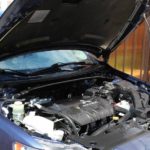Quick Navigation

It’s quite a fascinating fact for many that a car seems to run better when its mass airflow sensor is unplugged. However, one should not assume that it is not an essential component.
Before we dive into explaining why this happens, it’s necessary to understand a few fundamental facts regarding the mass airflow sensor.
Function Of Mass Air Flow Sensor
The mass airflow sensor detects how much air is going into the car’s engine so that it can push the right amount of fuel. A mixture of fuel and air in the correct ratio leads to combustion, which keeps the car running smoothly.
Different types of mass airflow sensors use different techniques to measure the volume and density of the air entering the engine. The hot wire type mass airflow sensor is the type, which is most common out there.
The hot wire type mass airflow sensor uses two wires, one hot and one cold. It measures how much current is needed to keep the wire hot. This helps it estimate the volume of air entering the engine.
Another type of mass airflow sensor is the vortex type. As the name suggests, the air is made to pass through a vortex equipped with waves. It then assesses the movement of the waves to deduce the volume of air entering the engine.
Why Do We Unplug The Mass Air Flow Sensor?
There are three main reasons to unplug the mass airflow sensor of a car:
- To check whether the mass airflow sensor is working properly.
- In order to check whether the other sensors are working correctly.
- To check whether the computer is working perfectly.
After unplugging the mass airflow sensor, if the car continues to function properly or ends up performing better than usual, it indicates that something is wrong with the mass airflow sensor.
However, if the car dies on unplugging the mass airflow sensor, this means that either the computer or some other sensor is malfunctioning.
What Really Happens On Unplugging The Mass Air Flow Sensor
This brings us to what happens when the mass airflow sensor is unplugged. We already know that mass airflow sensors estimate the quantity of air inflowing the engine. When this sensor is unplugged, the ECU gets switched to limp mode.
The computer has tables programmed into it to estimate the fuel volume that should be right for the engine. When it doesn’t receive any reading from the mass airflow sensor, it uses these tables to calculate and push a certain fuel amount.
Why The Car Runs Better On Unplugging The Mass Air Flow Sensor
In case the mass airflow sensor is faulty, it gives inaccurate readings to the computer. This impacts the fuel and air ratio in the engine, which ultimately affects the car’s performance. In such cases, when the mass airflow sensor is unplugged, the computer no longer receives the erroneous readings.
It can rely on the tables programmed into it and push a volume of fuel, which is more accurate. This leads to proper combustion and makes the car run better.
However, this is not the only possible outcome. If the mass airflow sensor was working fine, but some other component was faulty, the car might die on unplugging the car air flow sensor.
This means that the vehicle was heavily relying on the mass airflow sensor to function properly.
This could mean that the computer cannot retrieve the tables programmed into it and has to depend on the readings from the mass airflow sensor. If the computer isn’t the issue, some other sensor might be causing the problem.
Some cars have a rubber intake hose connecting the throttle body to the mass airflow sensor. The slightest crack in this hose could interfere with the readings. This doesn’t imply that the sensor is faulty; it simply cannot detect the entry of excess air.
Should You Keep The Mass Air Flow Sensor Unplugged?
The mass airflow sensor is unplugged to check whether various components are working fine. It’s true that in case of a faulty mass airflow sensor, unplugging it might make the car run better. But this is not a long-term arrangement you should rely on.
The tables programmed into the computer contain values suited to a new engine. With repeated use of the car, the engine undergoes wear and tear as well. These values may not be ideal for the engine for too long.
A good mass airflow sensor takes care of this. When it is working correctly, it tells the computer how much fuel to push, based on the engine’s capacity.
Hence, if your mass airflow sensor is not working properly, it’s not a good idea to keep the car running with the sensor unplugged. Instead, you should get the mass airflow sensor cleaned, fixed, or replaced to get the best performance.
When To Unplug The Mass Air Flow Sensor
We have already established that unplugging the mass airflow sensor is not some nifty hack to make your car work better. It is a method to detect issues with various components, and it should be treated as such.
You can consider unplugging the mass airflow sensor when your car seems to backfire. Even if you notice that your vehicle is running rough, this method can detect the underlying problem.
Since the mass airflow sensor is responsible for the fuel mixture, any fault in it could lead to mileage issues. If you observe that your car has been giving significantly lower mileage than it is supposed to, you can employ this test and check how that affects your car.
By now, you must have enough knowledge about the working of a mass airflow sensor to understand its importance. Be observant of your car’s performance and mileage, and cautiously decide whether unplugging the mass airflow sensor will help you figure out the issue.
Most importantly, never keep your car running for too long without the mass airflow sensor.

With comprehensive experience in writing exceptional quality articles and blogs about cars and related stuff, Daniel is one of the finest bloggers and a hardcore car lover we have. He is an ASE certified technician with an across-the-board experience of 10 years in the industry. He could not help tinkering with anything he got his hands on from a young age, which led to his remarkable career in the automotive repair industry.
When he is not under any hood, you can find him on the water or in the woods to pursue his passion for hunting and fishing. He has been writing for multiple sectors and is a regular contributor to several publications.
He currently owns a Nissan 300ZX TT and a Pearl Yellow but plans to upgrade it to 550 HP. His favorites include the Koenigsegg CCX and Lamborghini Diablo 6.0 VT, but for him, the Ferrari 360 Spider is one of the sexiest cars that exists to date.
Being an avid world traveler, he has spent most of his time analyzing the automotive markets, latest technology, and local favorites to enhance his knowledge base. He is currently living in North Caroline, where it’s all about food and coffee and, of course, cars.






